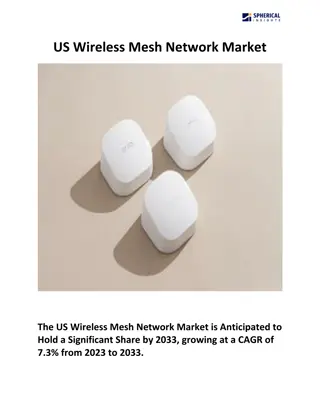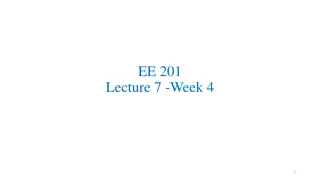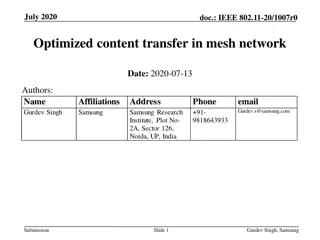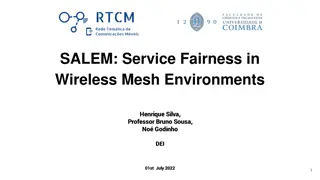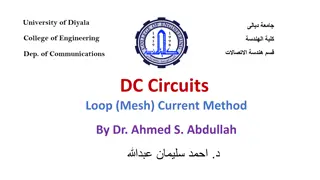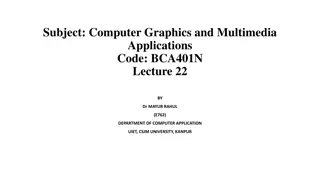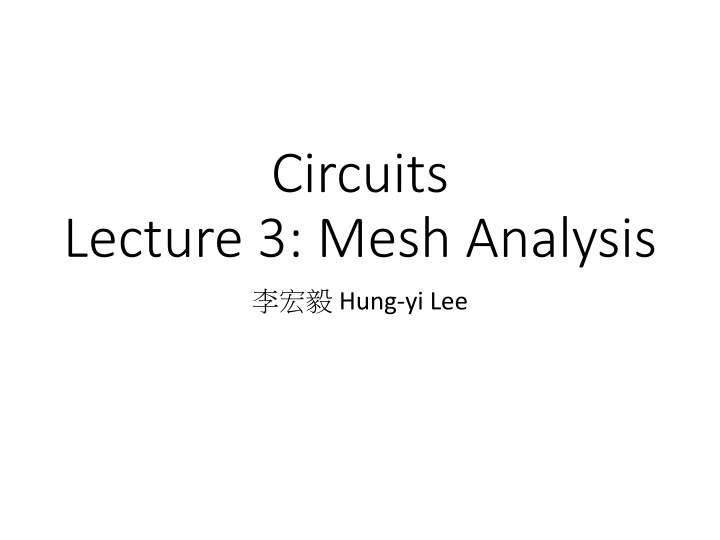
Mesh Analysis Techniques in Electrical Circuits
Explore the concept of mesh analysis in electrical circuits, presented through detailed lectures and visuals by Hung-yi Lee. Learn about finding mesh currents, applying Kirchhoff's Laws, representing voltages with mesh currents, handling different circuit components, and dealing with current sources. Discover methods for solving circuits with current sources located both on the perimeter and interior of the circuit structure.
Uploaded on | 1 Views
Download Presentation

Please find below an Image/Link to download the presentation.
The content on the website is provided AS IS for your information and personal use only. It may not be sold, licensed, or shared on other websites without obtaining consent from the author. If you encounter any issues during the download, it is possible that the publisher has removed the file from their server.
You are allowed to download the files provided on this website for personal or commercial use, subject to the condition that they are used lawfully. All files are the property of their respective owners.
The content on the website is provided AS IS for your information and personal use only. It may not be sold, licensed, or shared on other websites without obtaining consent from the author.
E N D
Presentation Transcript
Circuits Lecture 3: Mesh Analysis Hung-yi Lee
Mesh 1 Introduction Mesh 2 Mesh 3 Node analysis: Current + Voltage Voltage Potential Mesh analysis: Current + Voltage Current Mesh Current Mesh: closed current path that contains no closed paths within it (Textbook, P149) Meshes are holes in the circuits.
Mesh analysis i i i i 2 3 1 2 i i 1 3 Target of Mesh analysis is to find the mesh currents.
Mesh analysis + + = 0 i i i Consider KCL: b c d Represent ib, icand idby mesh current 1i ib= 2 i ic = = id 2i i 1 KCL is already fulfilled
Mesh analysis + + = v v v v Consider KVL: a b c s Represent va, vband vcby mesh current ( ) s a i i R = 1 v ( ) = b= v R i i R 1i v 1 2 c c b a
Mesh analysis For mesh 1: Ra(i1-is) + Rbi1 + Rc(i1-i2) =vs For mesh 2: Rc(i2-i1) + Rdi2 + Re(i2-i3) = 0 For mesh 3: Re(i3-i2) + Rfi3 + vs = 0 Can we always represent voltage by mesh currents?
Mesh analysis 3 cases Represent the voltage of (1) voltage sources, (2) resistor, and (3) current sources by mesh current
Mesh analysis - current sources 1. Current sources on the perimeter of the circuit
Mesh analysis - current sources 2. Interior current sources Method 1: Consider vsas unknown variables si sv + + + = = 0 v v v v v v Represent the voltages vd, vb, vcand ve . (except vs) by mesh current Solve mesh currents and vs One more equation: d b s c e s = is i i 2 1
Mesh analysis - current sources 2. Interior current sources when the current source is parallel with a resistor Method 2: Textbook: Chapter 2.5
Mesh analysis - current sources 2. Interior current sources when the current source is parallel with a resistor Method 2: Another point of view: The voltage of is isequal to Rs. ( ) = v R i i s s m x
Mesh analysis - current sources 2. Interior current sources Method 3: supermesh 3i ( ) ( ) ( ) = + R i i R i i i Rb i i 2 3 1 3 c c s 1 3 si sv Rd 1i R = i 2 e ( ) + R i i 1 e s = = s+ is i i i i i 2 1 2 1
Example 4.9 10i 1 ( ) 5 1 i 6 ( ) 4 31+ i 6(i1-5) + 10i1 + 3(i1+4) = 20 i1=2A
Exercise 4.11 Special case: current sources are parallel with resistors
Exercise 4.11 1 mA 3 i 6 k 1+ 2 i mA 1i 5 k ( ) ( ) + + + = 5 3 4 2 6 0 i k i m k i m k 1 1 1
Non-planar Circuit Mesh analysis cannot be applied on non-planar circuit Cannot transform this circuit into planar circuit
Non-planar Circuit Some non-planar circuits can be transformed into planar circuit B A C C A B
Non-planar Circuit Some non-planar circuits can be transformed into planar circuit
Non-planar Circuit Why mesh analysis cannot be applied on non- planar circuit? 6 meshes? 5 meshes
Node v.s. Mesh What is the final target? Node analysis is not suitable for current Mesh analysis is not suitable for voltage i v - + If node analysis is used, it is tedious to find i If mesh analysis is used, it is tedious to find v
Node v.s. Mesh Number of Equation: Number of Nodes v.s. Number of Meshes Number of Voltage sources v.s. Number of Current sources Use both to check your results
Homework 4.38 4.42
Answer 4.38 V1=24, v2=-16, v3=20 4.42 I1=3, i2=3.5, i3=3, v1=0, v2=15
Acknowledgement (b02)










